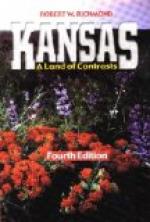In some respects Chicago deserves the name City of Contrasts, just as the United States is the Land of Contrasts; and in no way is this more marked than in the difference between its business and its residential quarters. In the one—height, narrowness, noise, monotony, dirt, sordid squalor, pretentiousness; in the other—light, space, moderation, homelikeness. The houses in the Lake Shore Drive, the Michigan Boulevard, or the Drexel Boulevard are as varied in style as the brown-stone mansions of New York are monotonous; they face on parks or are surrounded with gardens of their own; they are seldom ostentatiously large; they suggest comfort, but not offensive affluence; they make credible the possession of some individuality of taste on the part of their owners. The number of massive round openings, the strong rusticated masonry, the open loggie, the absence of mouldings, and the red-tiled roofs suggest to the cognoscenti that Mr. H.H. Richardson’s spirit was the one which brooded most efficaciously over the domestic architecture of Chicago. The two houses I saw that were designed by Mr. Richardson himself are undoubtedly not so satisfactory as some of his public buildings, but they had at least the merit of interest and originality; some of the numerous imitations were by no means successful.
The parks of Chicago are both large and beautiful. They contain not a few very creditable pieces of sculpture, among which Mr. St. Gaudens’ statue of Lincoln is conspicuous as a wonderful triumph of artistic genius over unpromising material. The show of flowers in the parks is not easily paralleled in public domains elsewhere. Of these, rather than of its stockyards and its lightning rapidity in pig-sticking, will the visitor who wishes to think well of Chicago carry off a mental picture.




